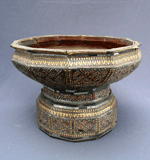COLLECTION
WOODEN OBJECTS
———————————————
PEDESTAL WITH FLORAL MOTIF ‘TAOK’
 Material:
Woven bamboo with black lacquer Material:
Woven bamboo with black lacquer
Dimensions: H: 175 cm W: 26.5 cm???
Date: XIXth - XXth century
Provenance: Third district, Phnom Penh
Collection: National Museum of Cambodia,
Phnom Penh
Gha.105 I.199
The north gallery of the National Museum exhibits ethno-graphic
objects used in daily life.
These objects are made from different materials such as wood, bamboo,
rattan, silver, parchment, iron, bronze, and horn.
Some objects are decorated with inlays of ivory,
mother-of-peal, coloured glass or lead, while others are lacquered.
Their shapes are varied: square, rectangular, circular and polygonal
(for supporting offerings such as fruit, cakes or sweetmeats, they
have similar purposes and forms such as uncovered trays and footed
pedestals.
By studying these items, we can understand the
talents of Khmer craftsmen and the techniques used. Ethnographic
items also give us some indication of the standards of living of
people who emerged from a great civilisation.
Traditionally, the Khmer used to decorate all things used on a daily
basis. Some decorative motifs were sculpted directly into the wood,
while others are made from applied lacquer. This substance is considered
a preventive material and also used as a support for decorative
motifs - particularly coloured glass or reflective materials.
Often boxes were shaped like animals such as birds,
monkeys, fish, Rajasimha (mythical lions) or frogs. These boxes
were used for various purposes such as betel containers, tobacco
boxes, and jewellery caskets.
This item is made from woven bamboo with lacquer.
It is decorated with lacquer shapes, which are ornamented by floral
motifs and incrusted by reflective glass.
One Cambodian post-Angkorian folktale entitled
‘Tum Teav’ indicates that a young monk named ‘Tum’
made this type of object. We can conclude that monks of this period
were also craftsmen.
| 

